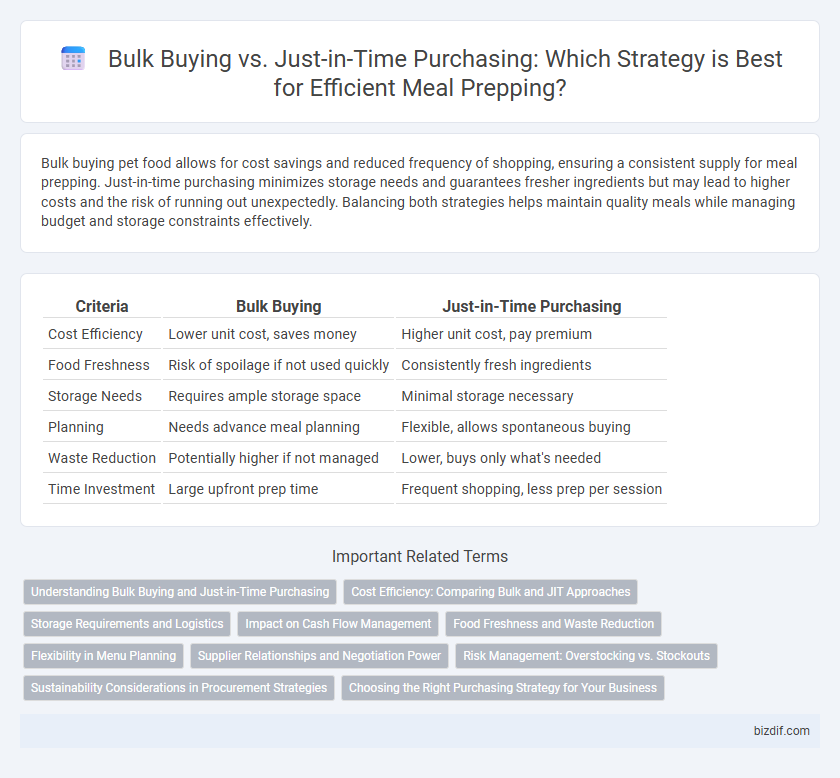Bulk buying pet food allows for cost savings and reduced frequency of shopping, ensuring a consistent supply for meal prepping. Just-in-time purchasing minimizes storage needs and guarantees fresher ingredients but may lead to higher costs and the risk of running out unexpectedly. Balancing both strategies helps maintain quality meals while managing budget and storage constraints effectively.
Table of Comparison
| Criteria | Bulk Buying | Just-in-Time Purchasing |
|---|---|---|
| Cost Efficiency | Lower unit cost, saves money | Higher unit cost, pay premium |
| Food Freshness | Risk of spoilage if not used quickly | Consistently fresh ingredients |
| Storage Needs | Requires ample storage space | Minimal storage necessary |
| Planning | Needs advance meal planning | Flexible, allows spontaneous buying |
| Waste Reduction | Potentially higher if not managed | Lower, buys only what's needed |
| Time Investment | Large upfront prep time | Frequent shopping, less prep per session |
Understanding Bulk Buying and Just-in-Time Purchasing
Bulk buying involves purchasing large quantities of ingredients upfront, which can reduce cost per unit and minimize frequent shopping trips. Just-in-time purchasing focuses on acquiring only the necessary ingredients close to their use date, ensuring freshness and reducing food waste. Understanding the balance between these strategies helps optimize meal prepping by managing budget, storage space, and ingredient quality effectively.
Cost Efficiency: Comparing Bulk and JIT Approaches
Bulk buying often reduces per-unit costs through volume discounts and lower shipping fees, enhancing overall meal prep cost efficiency. Just-in-time purchasing minimizes waste and storage expenses by acquiring only what is needed, preventing spoilage and excess inventory. Balancing bulk buying's savings with JIT's precision helps optimize budgeting and resource management in meal prepping.
Storage Requirements and Logistics
Bulk buying for meal prepping demands ample storage space, such as large refrigerators or pantry areas, to preserve food quality over extended periods and minimize spoilage risks. Just-in-time purchasing reduces storage needs by acquiring ingredients closer to their use date, streamlining kitchen logistics and minimizing inventory management challenges. Efficient inventory rotation and temperature-controlled storage are critical factors in balancing bulk buying benefits against the flexibility of just-in-time meal prep supply chains.
Impact on Cash Flow Management
Bulk buying for meal prepping improves cash flow management by reducing per-unit costs and minimizing frequent expenses, allowing for better budget allocation. Just-in-time purchasing requires careful monitoring of cash flow to avoid shortages but reduces storage costs and waste. Balancing both methods ensures optimized cash flow through strategic timing and inventory control.
Food Freshness and Waste Reduction
Bulk buying for meal prepping enhances food freshness by minimizing frequent exposure to air and contaminants, which often occurs in just-in-time purchasing. This method also significantly reduces food waste, as bulk ingredients can be portioned and stored properly, extending their shelf life. Just-in-time purchasing may lead to increased spoilage and waste due to irregular usage patterns and shorter storage periods.
Flexibility in Menu Planning
Bulk buying offers greater flexibility in menu planning by providing a diverse stock of ingredients that can be used for various meals throughout the week. Just-in-time purchasing limits options to only what is immediately needed, which can restrict creativity and adjustments based on changing preferences or schedules. Having a well-stocked pantry through bulk buying allows meal preppers to adapt menus spontaneously and reduce last-minute trips to the store.
Supplier Relationships and Negotiation Power
Bulk buying enhances supplier relationships by enabling larger order commitments that often lead to better negotiation power, including discounts and priority access to premium ingredients. Just-in-time purchasing requires flexible and responsive suppliers, emphasizing communication efficiency but may limit leverage in price negotiations due to smaller, frequent orders. Establishing long-term contracts with suppliers through bulk buying can secure favorable terms that streamline meal prepping operations and reduce overall costs.
Risk Management: Overstocking vs. Stockouts
Bulk buying in meal prepping reduces the risk of stockouts by ensuring a consistent supply of ingredients, but it increases the risk of overstocking, leading to potential food waste and higher storage costs. Just-in-time purchasing minimizes overstocking and waste by acquiring ingredients as needed, but it carries a higher risk of stockouts, which can disrupt meal preparation schedules. Effective risk management balances inventory levels to optimize freshness, cost-efficiency, and meal plan reliability.
Sustainability Considerations in Procurement Strategies
Bulk buying reduces packaging waste and lowers carbon footprints by minimizing frequent transportation trips, enhancing overall sustainability in meal prepping. Just-in-time purchasing limits food spoilage and waste by ensuring fresher ingredients but may increase packaging use and delivery emissions. Evaluating local supplier proximity, storage capacity, and packaging materials is crucial for optimizing sustainable procurement in meal preparation.
Choosing the Right Purchasing Strategy for Your Business
Selecting the appropriate purchasing strategy depends on your business's storage capacity and demand predictability; bulk buying minimizes unit costs and secures inventory for meal prepping but increases storage needs and risk of spoilage. Just-in-time purchasing reduces waste and maintains freshness by ordering ingredients as needed, ideal for perishable items with fluctuating demand. Evaluating supplier reliability, cash flow constraints, and production schedules ensures optimal alignment with your meal prepping operations and customer satisfaction.
Bulk buying vs just-in-time purchasing Infographic

 bizdif.com
bizdif.com